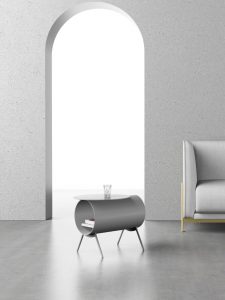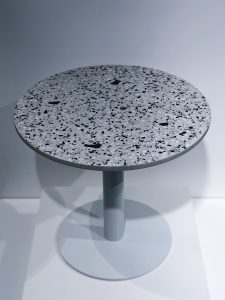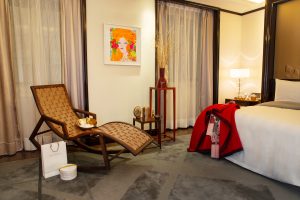Maison & Objet trade show is looking towards China this year for its Rising Talent Awards. The six designers selected – only men, which one can only regret, the objective of the Awards being to promote talents supposed to embody modernity and sketch the China of tomorrow – expose their creations at Galeries Lafayette Haussmann until February 19th.
After Lebanon and Italy, the 5th edition of the Rising Talent Awards is focusing this year on China. To form its jury, Maison & Objet gathered seven personalities from the Chinese or Western design world. Among them are Qu Guangci, founder of the X + Q Art design brand, as well as London designer Tom Dixon. The jury selected six young Chinese designers, all born and working in China (with the exception of Hongjie Yang who lives in the Netherlands), some having studied abroad.
Italian industrial designer Luca Nichetto, a member of the jury, points out: « The most interesting thing is the search for identity of the Chinese designer, this refusal to be a copy-paste of Western design, and to blend in with the centuries-old heritage and rich traditions of Chinese craftsmanship. So far, everything shows us that they are going in the right direction. I am very curious to see how that will evolve. »
Searching for their own cultural language
Another member of the jury, Lyndon Neri, co-founder of Shanghai firm Neri & Hu, adds: « Faced with the rapid growth of China’s economy and its need to forge its own cultural language, many emerging designers have begun to work on the problem of inheritance and identity. And this, each with their own voice. »
One of the ‘rising talents’, Pekingese Franck Chou, conceived the Middle chair, inspired by the traditional Chinese bamboo chair. He also designed a Combo modular sofa made using hand-made upholstery processes, updated with combinations of leather, wool and fabric. « My creations contain no obvious oriental features, but in reality their ideas and inspiration come from deep reflections on modern and future Oriental lifestyles », he explains.

Another selected talent, Ximi Li, founder of the furniture brand URBANCRAFT based in Shanghai, said he was very impressed by the Italian designer Andrea Branzi with whom he worked from 2009 to 2010. « Thanks to my experiences in China and Italy, I ask myself some questions: can my creations be understood by the Europeans? Will the Chinese feel affected by my designs? », he wonders. The URBANCRAFT collections include the Jiazhuang dressing table in stainless steel, leather and oak wood, inspired by the traditional Chinese jewelry cabinet.

Awareness of environmental issues
Based in Hangzhou after touring China and Nepal, Mario Tsai has a mantra: ‘less materials for a better design’. He imagined a table system that requires only one type of foot, substitutable, to use on tables of different sizes. « I always try to use fewer materials and limit production steps to create better designs. This not only saves costs for my customers, it also saves resources and protects the environment. This mantra reminds me to always follow a sustainable design approach. »

These concerns are shared by Hongjie Yang, whose creations combine clean lines with a clutter of raw material. Its Synthesis Monolith mirror, coffee table and aluminum bench are both natural and intricate, evoking half-finished sculptures. « In my opinion, nature as we know it is coming to an end. Many of my works are the result of my search for a new kind of aesthetic that transcends the cleavage between man’s power and nature », he says.
Chen Xingyu, co-founder of the design brand Bentu, is interested in the regeneration of materials. To him, the purpose of design is to discover the important problems that exist in society and to provide solutions. « After the rapid development of China, we quickly saw the impact of overcapacity on the territory and on society. As designers, we absolutely have to do something », he claims. « We must pay special attention to waste and unnecessary materials in today’s industry, such as construction waste, charcoal, daily ceramic waste, yak dung on the Tibetan plateau, the bone ash and even the stony rubbish. Through design and industrial production, we can turn them into objects. »

Bentu’s latest Terrazzo collection (pictured above), recycles ceramic waste from the city of Foshan (in the Chinese southern Guangdong province), a major center of the ceramic industry. The collection is inspired by the original texture of the terrazzo and uses concrete, remnants of stone aggregates and ceramic waste to make products such as Yuan Plantpot or Tu and Planet suspensions.
An industry still in its infancy
Chen Furong, founder of the brand WUU, conducts extensive research on materials and craftsmanship, which he combines with technology. He created the Touchable Light lamps whose encapsulated components allow automatic adjustment. To him, these years of strong growth that saw China establish itself as a global leader in the industrial supply chain had an impact. « China’s craftsmanship has a long history, rooted in the development of our country’s traditions and culture. We count many different crafts, all fascinating, from the simplest to the most exquisite, all of which reveal the characteristics and the way of thinking of the Orient. However, due to very rapid economic development, crafts seem to have lost their importance. When the pace slows down finally, we will have more time to reflect on how we see life, Chinese craftsmanship will develop further in contemporary society », he hopes.
The time has not come yet when Chinese designers will be able to rely on the powerful local manufacturing base. Because many challenges still lie ahead. « I think that the underlying basis of the implementation of the design industry is too weak », believes Franck Chou. « A concept cannot be isolated and implemented independently. We need trade, manufacturing, management and brand management adapted to the world of design, as well as business values for design and ecological platforms to support us. The development of design in China is just beginning, but it may be the best time for designers. » Even more so as Western critics are beginning to take Chinese creators seriously. Like the fashion designers, who will be able to compete this year during the inaugural edition of BoF China Prize , launched by the online news website Business of Fashion.





